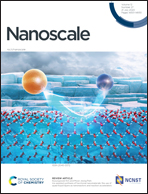Nonlinear optical ASnX (A = Na, H; X = N, P) nanosheets with divalent tin lone electron pair effect by first-principles design†
Abstract
We propose a series of novel ASnX (A = Na, H; X = N, P) layered structures based on first-principles modeling and simulation. These nanosheet materials are all derived from the rational design for the parent structures of NaSnX (X = N, P) with unique divalent tin lone electron pairs. First-principles calculations show that the polar divalent tin effect can lead to strong second-order nonlinear optical (NLO) and large birefringence response in bulk materials, and can also greatly enhance the second harmonic generation (SHG) effect in the corresponding two-dimensional (2D) nanostructures by hydrogen passivation or strain engineering. The correlation between structural evolution and bandgap is illustrated through detailed analysis of the electronic structure and charge transfer model. The SHG effect and its origin can be further evaluated based on the SHG-weighted density scheme, which will facilitate the NLO research of 2D materials in the nitride and phosphide systems.

- This article is part of the themed collection: Celebrating 60 years of the Fujian Institute of Research on the Structure of Matter


 Please wait while we load your content...
Please wait while we load your content...